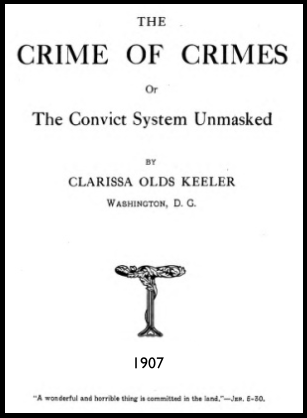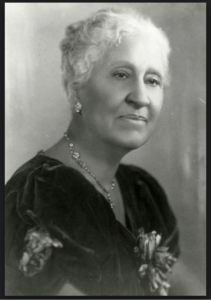
~~~~~~~~~~~~~~~~~~~~~~~~~~~~~~~~~~~~~~~~~~~~
Birmingham, Alabama – Women Convicts Sold for 15 Cents a Day
`
From the Duluth Labor World of December 22, 1917:
WOMEN CONVICTS BEING SOLD
FOR 15 CENTS A DAY
—–
Vicious Practice of the Dark Ages
Still Obtains in Alabama.
—–
BIRMINGHAM, Ala., Dec. 20.— Women convicts in this state are sold to contractors for 15 cents a day and are housed in filthy stockades while candidates for the governorship talk of the “gradual” removal of this glaring evil, declares the Monthly Bulletin of the Alabama state federation of labor.
This publication says:
Under a recent date line, Escambia county, state of Alabama, rises to remark that Escambia county has made a most advantageous contract with a certain employing concern, where the county has leased its women convicts for two years for the munificent sum of 15 cents per day. Such things make us wonder if we are still in the dark ages, with all the blind ignorance of human instincts, with all the intollerant cruelty of the old savage slave dealer and buyer, and this happened in the enlightened state of Alabama. Women, sold into slavery to the highest bidder, to do whatever that bidder desires; work, slave, toil through the days; rest in stockades, filthy and unfit, for the nights; truly a picture upon which every Alabamian should look with pride; and candidates for the governorship favor the “gradual” removal of convicted persons from the mines and lumber camps.
For years and years labor has fought this system of slavery in the state. Governors have promised to abolish it, legislatures have promised to abolish it; the people have demanded its abolishment, but when it comes to weighing the human soul against the almighty dollar the dollar wins every time. Poor, indeed, must be that state which has to sell its legal slaves into involuntary servitude that it may use the revenue thus obtained to pay its teachers, to pay its officers, to pay its expenses in other ways, to pay the jurors who send the unfortunates to the mines; to pay the judges who pronounce sentence.
And not a man offers for office in the state but who will wink at this inhuman traffic in human souls; not one of them will come out flatly for the abolition of this traffic.
[Photograph added of “Crime of Crimes” by Clarissa Olds Keeler.]
SOURCE
The Labor World
(Duluth, Minnesota)
-Dec 22, 1917
https://chroniclingamerica.loc.gov/lccn/sn78000395/1917-12-22/ed-1/seq-1/
IMAGES
“The Crime of Crimes, The Convict System Unmasked”
-by Clarissa Olds Keeler
WDC, 1907 (29 pages, full view)
https://babel.hathitrust.org/cgi/pt?id=uiug.30112100027660;view=2up;seq=4
Mary Church Terrell (1863-1954)
& see article by Michael Barga
See also:
The Allentown Leader (PA) of Dec 28, 1917
indicates that it was the practice in Alabama
to lease out African-American prisoners:
https://www.newspapers.com/image/70422864/
Lease Women Convicts For
Labor In Alabama
—–Special to The Leader.
Mobile, Ala., Dec. 28.-At the next session of the State Legislature a measure will probably be introduced looking to prohibiting counties from leasing women convicts. A sensation was recently created when the Escambia County Commissioners leased negro women prisoners to a contractor for 15¢ a day, for a term of two years. For years male prisoners have been leased to mine operators and other employers of labor, but this was the first instance where women had been leased. Until the war made a strong demand for labor there was no market for the negro women prisoners. But in certain lines of work it has been found they have a small earning capacity and other counties will probably follow the lead of Escambia.
———-
For more on the Convict Lease System:
Organized Labor and the Black Worker, 1619-1981
-by Philip S Foner
International Publishers, 1982
https://books.google.com/books?id=zY4FAQAAIAAJ
Chapter 8: The Black Worker on the Eve of World War I
…..When the Industrial Revolution swept through the South after 1880, jobs in the new textile, iron, and steel factories fell to the poor whites. The black man’s share of the South’s industrial development was limited to the dirty, disagreeable tasks of unskilled labor. Of course, there were black miners, especially in Alabama, where 46.2 per cent of the coal miners in 1889 were Negroes. But many of them worked under the convict lease system. In January, 1888, the State of Alabama gave an exclusive contract to the Tennessee Coal, Iron and Railroad Company, the chief coal operator in the state, on condition that the company use all convicts who were able to work. Blacks were arrested for trivial reasons or for no reason at all and sentenced to work out their penalty in the mines. The contract gave the company cheap labor-it compensated the state at a rate ranging from $9.00 to $18.00 a month per convict, depending on his classification-and at the same time saved the state money. In other Southern states, especially Georgia, the convict-lease system supplied cheap black labor to companies building railroads or cutting timber…
1901- W. E B. DuBois on the Convict Lease System:
From The Missionary Review of the World of October 1901-
https://babel.hathitrust.org/cgi/pt?id=mdp.39015038674043;view=2up;seq=784
The Spawn of Slavery
The Convict-Lease System in the South
-by Professor W. E. Burghardt DuBois
Professor of Economics in Atlanta University, Georgia.
1907-Mary Church Terrell on the Convict Lease System:
The Nineteenth Century and After, Volume 62
-A Monthly Review
-ed by James Knowles
July-Dec 1907
Leonard Scott Publishing Company, 1907
https://books.google.com/books?id=m-EaAAAAYAAJ
Edition of August 1907
https://play.google.com/books/reader?id=m-EaAAAAYAAJ&printsec=frontcover&output=reader&hl=en&pg=GBS.PA177
“Peonage in the United States,
The Convict Lease System and the Chain Gangs”
-by Mary Church Terrell
https://play.google.com/books/reader?id=m-EaAAAAYAAJ&printsec=frontcover&output=reader&hl=en&pg=GBS.PA306
PEONAGE IN THE UNITED STATES
THE CONVICT LEASE SYSTEM AND THE CHAIN GANGS
[by Mary Church Terrell]
In the chain gangs and convict lease camps of the South to-day are thousands of coloured people, men, women, and children, who are enduring a bondage, in some respects more cruel and more crushing than that from which their parents were emancipated forty years ago. Under this modern regime of slavery thousands of coloured people, frequently upon trumped-up charges or for offences which in a civilised community would hardly land them in gaol, are thrown into dark, damp, disease-breeding cells, whose cubic contents are less than those of a good-sized grave, are overworked, underfed, and only partially covered with vermin-infested rags. As the chain gangs and the convict lease system are operated in the South to-day they violate the law against peonage, the constitutionality of which was affirmed by the Supreme Court two years ago. In the famous case of Clyatt versus the United States, Attorney-General Moody, recently placed upon the bench of the Supreme Court, represented the Government, while Senator Bacon and others appeared for Clyatt, a resident of Georgia, who had been convicted in the Federal Courts of that State and sentenced to four years’ hard labour on the charge of having held two coloured men in peonage on account of debt, in violation of the law. In his brief, Attorney Moody declared that the executive arm of the law, so far as the enforcement of the statute against peonage was concerned, has been practically paralysed.
Notwithstanding the fact that several United States Courts have held this law to be constitutional [said Judge Moody], the Government is powerless to compel its enforcement or observance, even in the most typical and flagrant cases. We think we may truthfully say [continues Judge Moody], that upon the decision of this case (Clyatt v. the United States) hangs the liberty of thousands of persons, mostly coloured, it is true, who are now being held in a condition of involuntary servitude, in many cases worse than slavery itself, by the unlawful acts of individuals, not only in violation of the thirteenth amendment to the constitution, but in violation of the law which we have under consideration.
[…..x17 pages]
[Photograph of MCT added.]
Clyatt v. United States, 197 U.S. 207 (1905)
https://supreme.justia.com/cases/federal/us/197/207/


